| Meiosis | Mitosis | Hide All | |
|---|---|---|---|
| Occurs in: | Humans, animals, plants, fungi | all organisms | hide |
| Produces: | four haploid daughter cells | two diploid daughter cells | hide |
| Genetically: | different | identical | hide |
| Definition: | A type of cellular reproduction in which the number of chromosomes are reduced by half through the separation of homologous chromosomes in a diploid cell. | A process of asexual reproduction in which the cell divides in two producing a replica (exact copy) with an equal number of chromosomes (One cell becomes two) in haploid cell | hide |
| Chromosome Number: | Reduced by half (homologous pairs separate) | Remains the same | hide |
| Pairing of Homologues: | Yes | No | hide |
| Function: | sexual reproduction | Cellular (asexual) Reproduction (cell division during which the cell nucleus divides); general growth and repair of the body | hide |
| Number of Divisions: | 2 nuclear and 2 cytoplasmic divisions | 1 division of the nucleus and 1 Cytokinesis | hide |
| Discovered by: | Oscar Hertwig | Walther Flemming | hide |
| Type of Reproduction: | Sexual | Asexual | hide |
| Number of Cells produced: | 4 | 2 | hide |
| Creates: | Sex cells only: Female egg cells or Male sperm cells | Makes everything other than sex cells (Somatic Cells) | hide |
| Occurrence of Crossing Over: | Yes | No | hide |
| Steps: | The steps of meiosis are Interphase, Prophase I, Metaphase I, Anaphase I, Telophase I, Prophase II, Metaphase II, Anaphase II and Telophase II. | The steps of mitosis are Interphase, Prophase, Metaphase, Anaphase, Telophase and Cytokinesis | hide |
Thursday, July 22, 2010
Differences Mitosis and Meiosis
Posted by ct Nap at 6:53 AM 0 comments
Significance of Meiosis
Meiosis facilitates stable sexual reproduction. Without the halving of ploidy, or chromosome count, fertilization would result in zygotes that have twice the number of chromosomes as the zygotes from the previous generation. Successive generations would have an exponential increase in chromosome count. In organisms that are normally diploid, polyploidy, the state of having three or more sets of chromosomes, results in extreme developmental abnormalities or lethality [4]. Polyploidy is poorly tolerated in most animal species. Plants, however, regularly produce fertile, viable polyploids. Polyploidy has been implicated as an important mechanism in plant speciation.
Most importantly, recombination and independent assortment of homologous chromosomes allow for a greater diversity of genotypes in the population. This produces genetic variation in gametes that promote genetic and phenotypic variation in a population of offspring.
Posted by ct Nap at 6:45 AM 0 comments
Phases Of Meiosis
Meiosis I
Meiosis I separates homologous chromosomes, producing two haploid cells (N chromosomes, 23 in humans), so meiosis I is referred to as a reductional division. A regular diploid human cell contains 46 chromosomes and is considered 2N because it contains 23 pairs of homologous chromosomes. However, after meiosis I, although the cell contains 46 chromatids, it is only considered as being N, with 23 chromosomes. This is because later, in Anaphase I, the sister chromatids will remain together as the spindle pulls the pair toward the pole of the new cell. In meiosis II, an equational division similar to mitosis will occur whereby the sister chromatids are finally split, creating a total of 4 haploid cells (23 chromosomes, N) per daughter cell from the first division.
Prophase I
During prophase I, DNA is exchanged between homologous chromosomes in a process called homologous recombination. This often results in chromosomal crossover. The new combinations of DNA created during crossover are a significant source of genetic variation, and may result in beneficial new combinations of alleles. The paired and replicated chromosomes are called bivalents or tetrads, which have two chromosomes and four chromatids, with one chromosome coming from each parent. At this stage, non-sister chromatids may cross-over at points called chiasmata (plural; singular chiasma).
Leptotene
The first stage of prophase I is the leptotene stage, also known as leptonema, from Greek words meaning "thin threads".[1] During this stage, individual chromosomes begin to condense into long strands within the nucleus. However the two sister chromatids are still so tightly bound that they are indistinguishable from one another.
Zygotene
The zygotene stage, also known as zygonema, from Greek words meaning "paired threads",[1] occurs as the chromosomes approximately line up with each other into homologous chromosome pairs. This is called the bouquet stage because of the way the telomeres cluster at one end of the nucleus. At this stage, the synapsis (pairing/coming together) of homologous chromosomes takes place.
Pachytene
The pachytene stage, also known as pachynema, from Greek words meaning "thick threads",[1] contains the following chromosomal crossover. Nonsister chromatids of homologous chromosomes randomly exchange segments of genetic information over regions of homology. Sex chromosomes, however, are not wholly identical, and only exchange information over a small region of homology. Exchange takes place at sites where recombination nodules (the chiasmata) have formed. The exchange of information between the non-sister chromatids results in a recombination of information; each chromosome has the complete set of information it had before, and there are no gaps formed as a result of the process. Because the chromosomes cannot be distinguished in the synaptonemal complex, the actual act of crossing over is not perceivable through the microscope.
Diplotene
During the diplotene stage, also known as diplonema, from Greek words meaning "two threads",[1] the synaptonemal complex degrades and homologous chromosomes separate from one another a little. The chromosomes themselves uncoil a bit, allowing some transcription of DNA. However, the homologous chromosomes of each bivalent remain tightly bound at chiasmata, the regions where crossing-over occurred. The chiasmata remain on the chromosomes until they are severed in Anaphase I.
In human fetal oogenesis all developing oocytes develop to this stage and stop before birth. This suspended state is referred to as the dictyotene stage and remains so until puberty. In males, only spermatogonia (spermatogenesis) exist until meiosis begins at puberty.
Diakinesis
Chromosomes condense further during the diakinesis stage, from Greek words meaning "moving through".[1] This is the first point in meiosis where the four parts of the tetrads are actually visible. Sites of crossing over entangle together, effectively overlapping, making chiasmata clearly visible. Other than this observation, the rest of the stage closely resembles prometaphase of mitosis; the nucleoli disappear, the nuclear membrane disintegrates into vesicles, and the meiotic spindle begins to form.
Synchronous processes
During these stages, two centrosomes, containing a pair of centrioles in animal cells, migrate to the two poles of the cell. These centrosomes, which were duplicated during S-phase, function as microtubule organizing centers nucleating microtubules, which are essentially cellular ropes and poles. The microtubules invade the nuclear region after the nuclear envelope disintegrates, attaching to the chromosomes at the kinetochore. The kinetochore functions as a motor, pulling the chromosome along the attached microtubule toward the originating centriole, like a train on a track. There are four kinetochores on each tetrad, but the pair of kinetochores on each sister chromatid fuses and functions as a unit during meiosis I.[2][3]
Microtubules that attach to the kinetochores are known as kinetochore microtubules. Other microtubules will interact with microtubules from the opposite centriole: these are called nonkinetochore microtubules or polar microtubules. A third type of microtubules, the aster microtubules, radiates from the centrosome into the cytoplasm or contacts components of the membrane skeleton.
Metaphase I
Homologous pairs move together along the metaphase plate: As kinetochore microtubules from both centrioles attach to their respective kinetochores, the homologous chromosomes align along an equatorial plane that bisects the spindle, due to continuous counterbalancing forces exerted on the bivalents by the microtubules emanating from the two kinetochores of homologous chromosomes. The physical basis of the independent assortment of chromosomes is the random orientation of each bivalent along the metaphase plate, with respect to the orientation of the other bivalents along the same equatorial line.
Anaphase I
Kinetochore(bipolar spindles) microtubules shorten, severing the recombination nodules and pulling homologous chromosomes apart. Since each chromosome has only one functional unit of a pair of kinetochores[3], whole chromosomes are pulled toward opposing poles, forming two haploid sets. Each chromosome still contains a pair of sister chromatids. Nonkinetochore microtubules lengthen, pushing the centrioles farther apart. The cell elongates in preparation for division down the center.
Telophase I
The last meiotic division effectively ends when the chromosomes arrive at the poles. Each daughter cell now has half the number of chromosomes but each chromosome consists of a pair of chromatids. The microtubules that make up the spindle network disappear, and a new nuclear membrane surrounds each haploid set. The chromosomes uncoil back into chromatin. Cytokinesis, the pinching of the cell membrane in animal cells or the formation of the cell wall in plant cells, occurs, completing the creation of two daughter cells. Sister chromatids remain attached during telophase I.
Cells may enter a period of rest known as interkinesis or interphase II. No DNA replication occurs during this stage.
Meiosis II
Meiosis II is the second part of the meiotic process. Much of the process is similar to mitosis. The end result is production of four haploid cells (23 chromosomes, 1N in humans) from the two haploid cells (23 chromosomes, 1N * each of the chromosomes consisting of two sister chromatids) produced in meiosis I. The four main steps of Meiosis II are: Prophase II, Metaphase II, Anaphase II, and Telophase II.
In prophase II we see the disappearance of the nucleoli and the nuclear envelope again as well as the shortening and thickening of the chromatids. Centrioles move to the polar regions and arrange spindle fibers for the second meiotic division.
In metaphase II, the centromeres contain two kinetochores that attach to spindle fibers from the centrosomes (centrioles) at each pole. The new equatorial metaphase plate is rotated by 90 degrees when compared to meiosis I, perpendicular to the previous plate[citation needed].
This is followed by anaphase II, where the centromeres are cleaved, allowing microtubules attached to the kinetochores to pull the sister chromatids apart. The sister chromatids by convention are now called sister chromosomes as they move toward opposing poles.
The process ends with telophase II, which is similar to telophase I, and is marked by uncoiling and lengthening of the chromosomes and the disappearance of the spindle. Nuclear envelopes reform and cleavage or cell wall formation eventually produces a total of four daughter cells, each with a haploid set of chromosomes. Meiosis is now complete and ends up with four new daughter cells.
Posted by ct Nap at 6:33 AM 0 comments
Differences Mitosis and Meiosis
| Meiosis | Mitosis | Hide All Show All | |
|---|---|---|---|
| Occurs in: | Humans, animals, plants, fungi | all organisms | hide |
| Produces: | four haploid daughter cells | two diploid daughter cells | hide |
| Genetically: | different | identical | hide |
| Definition: | A type of cellular reproduction in which the number of chromosomes are reduced by half through the separation of homologous chromosomes in a diploid cell. | A process of asexual reproduction in which the cell divides in two producing a replica (exact copy) with an equal number of chromosomes (One cell becomes two) in haploid cell | hide |
| Chromosome Number: | Reduced by half (homologous pairs separate) | Remains the same | hide |
| Pairing of Homologues: | Yes | No | hide |
| Function: | sexual reproduction | Cellular (asexual) Reproduction (cell division during which the cell nucleus divides); general growth and repair of the body | hide |
| Number of Divisions: | 2 nuclear and 2 cytoplasmic divisions | 1 division of the nucleus and 1 Cytokinesis | hide |
| Discovered by: | Oscar Hertwig | Walther Flemming | hide |
| Type of Reproduction: | Sexual | Asexual | hide |
| Number of Cells produced: | 4 | 2 | hide |
| Creates: | Sex cells only: Female egg cells or Male sperm cells | Makes everything other than sex cells (Somatic Cells) | hide |
| Occurrence of Crossing Over: | Yes | No | hide |
| Steps: | The steps of meiosis are Interphase, Prophase I, Metaphase I, Anaphase I, Telophase I, Prophase II, Metaphase II, Anaphase II and Telophase II. | The steps of mitosis are Interphase, Prophase, Metaphase, Anaphase, Telophase and Cytokinesis | hide |
Posted by ct Nap at 6:05 AM 0 comments
Occurrence of meiosis in eukaryotic life cycle
Meiosis occurs in eukaryotic life cycles involving sexual reproduction, comprising of the constant cyclical process of meiosis and fertilization. This takes place alongside normal mitotic cell division. In multicellular organisms, there is an intermediary step between the diploid and haploid transition where the organism grows. The organism will then produce the germ cells that continue in the life cycle. The rest of the cells, called somatic cells, function within the organism and will die with it.
Cycling meiosis and fertilization events produces a series of transitions back and forth between alternating haploid and diploid states. The organism phase of the life cycle can occur either during the diploid state (gametic or diploid life cycle), during the haploid state (zygotic or haploid life cycle), or both (sporic or haplodiploid life cycle, in which there two distinct organism phases, one during the haploid state and the other during the diploid state). In this sense, there are three types of life cycles that utilize sexual reproduction, differentiated by the location of the organisms phase(s).
In the gametic life cycle, of which humans are a part, the species is diploid, grown from a diploid cell called the zygote. The organism's diploid germ-line stem cells undergo meiosis to create haploid gametes (the spermatozoa for males and ova for females), which fertilize to form the zygote. The diploid zygote undergoes repeated cellular division by mitosis to grow into the organism. Mitosis is a related process to meiosis that creates two cells that are genetically identical to the parent cell. The general principle is that mitosis creates somatic cells and meiosis creates germ cells.
In the zygotic life cycle the species is haploid instead, spawned by the proliferation and differentiation of a single haploid cell called the gamete. Two organisms of opposing gender contribute their haploid germ cells to form a diploid zygote. The zygote undergoes meiosis immediately, creating four haploid cells. These cells undergo mitosis to create the organism. Many fungi and many protozoa are members of the zygotic life cycle.
Finally, in the sporic life cycle, the living organism alternates between haploid and diploid states. Consequently, this cycle is also known as the alternation of generations. The diploid organism's germ-line cells undergo meiosis to produce spores. The spores proliferate by mitosis, growing into a haploid organism. The haploid organism's germ cells then combine with another haploid organism's cells, creating the zygote. The zygote undergoes repeated mitosis and differentiation to become the diploid organism again. The sporic life cycle can be considered a fusion of the gametic and zygotic life cycles.
Process
Because meiosis is a "one-way" process, it cannot be said to engage in a cell cycle as mitosis does. However, the preparatory steps that lead up to meiosis are identical in pattern and name to the interphase of the mitotic cell cycle.
Interphase is divided into three phases:
- Growth 1 (G1) phase: This is a very active period, where the cell synthesizes its vast array of proteins, including the enzymes and structural proteins it will need for growth. In G1 stage each of the chromosomes consists of a single (very long) molecule of DNA. In humans, at this point cells are 46 chromosomes, 2N, identical to somatic cells.
- Synthesis (S) phase: The genetic material is replicated: each of its chromosomes duplicates, producing 46 chromosomes each made up of two sister chromatids. The cell is still considered diploid because it still contains the same number of centromeres. The identical sister chromatids have not yet condensed into the densely packaged chromosomes visible with the light microscope. This will take place during prophase I in meiosis.
- Growth 2 (G2) phase: G2 phase is absent in Meiosis
Interphase is followed by meiosis I and then meiosis II. Meiosis I consists of separating the pairs of homologous chromosome, each made up of two sister chromatids, into two cells. One entire haploid content of chromosomes is contained in each of the resulting daughter cells; the first meiotic division therefore reduces the ploidy of the original cell by a factor of 2.
Meiosis II consists of decoupling each chromosome's sister strands (chromatids), and segregating the individual chromatids into haploid daughter cells. The two cells resulting from meiosis I divide during meiosis II, creating 4 haploid daughter cells. Meiosis I and II are each divided into prophase, metaphase, anaphase, and telophase stages, similar in purpose to their analogous subphases in the mitotic cell cycle. Therefore, meiosis includes the stages of meiosis I (prophase I, metaphase I, anaphase I, telophase I), and meiosis II (prophase II, metaphase II, anaphase II, telophase II).
Meiosis generates genetic diversity in two ways: (1) independent alignment and subsequent separation of homologous chromosome pairs during the first meiotic division allows a random and independent selection of each chromosome segregates into each gamete; and (2) physical exchange of homologous chromosomal regions by homologous recombination during prophase I results in new combinations of DNA within chromosomes.
Posted by ct Nap at 5:47 AM 0 comments
Meaning Meiosis
Meiosis (a Greek word meaning "decrease") is a cellular process that forms the basis for sexual reproduction, together with syngamy. It is a form of nuclear division by which a diploid parent produces four haploid daughter cells. The process includes the two stages of nuclear division (meiosis I and II), usually accompanied by cell division. Single-stage meiosis has been suggested but not convincingly demonstrated. Duplication of chromosomes precedes the process of meiosis. Most animals and plants are normally diploid, and use meiosis to produce gametes, which fuse to form zygotes that develop into new organisms. This is often the primary or only means of proliferation. In other eukaryotes, sexual reproduction may play a more restricted role.
The mechanistic differences between mitosis, which produces somatic cells, and meiosis, is best understood by considering mitosis first. (All jargon used in this article is defined in the article on mitosis.)
As described earlier, meiotic nuclear division consists of two stages, called meiosis I and meiosis II. It starts with a cell in the same state as does a mitotic division. However, the alignment of chromosomes for prophase is different. Homologous chromosomes join into tetrads (so called because each tetrad contains four chromatids), and the tetrads line up on the metaphase plane.
| |
.
Posted by ct Nap at 5:43 AM 0 comments
Tuesday, July 20, 2010
Significant Mitosis
Mitosis is important for the maintenance of the chromosomal set; each cell formed receives chromosomes that are alike in composition and equal in number to the chromosomes of the parent cell. Transcription is generally believed to cease during mitosis, but epigenetic mechanisms such as bookmarking function during this stage of the cell cycle to ensure that the "memory" of which genes were active prior to entry into mitosis are transmitted to the daughter cells.[21]
Posted by ct Nap at 8:14 PM 0 comments
Phases of cell cycle and mitosis
Interphase
The mitotic phase is a relatively short period of the cell cycle. It alternates with the much longer interphase, where the cell prepares itself for cell division. Interphase is therefore not part of mitosis. Interphase is divided into three phases, G1 (first gap), S (synthesis), and G2 (second gap). During all three phases, the cell grows by producing proteins and cytoplasmic organelles. However, chromosomes are replicated only during the S phase. Thus, a cell grows (G1), continues to grow as it duplicates its chromosomes (S), grows more and prepares for mitosis (G2), and finally divides (M) before restarting the cycle.[5]
Preprophase
In plant cells only, prophase is preceded by a pre-prophase stage. In highly vacuolated plant cells, the nucleus has to migrate into the center of the cell before mitosis can begin. This is achieved through the formation of a phragmosome, a transverse sheet of cytoplasm that bisects the cell along the future plane of cell division. In addition to phragmosome formation, preprophase is characterized by the formation of a ring of microtubules and actin filaments (called preprophase band) underneath the plasma membrane around the equatorial plane of the future mitotic spindle. This band marks the position where the cell will eventually divide. The cells of higher plants (such as the flowering plants) lack centrioles: with microtubules forming a spindle on the surface of the nucleus and then being organized into a spindle by the chromosomes themselves, after the nuclear membrane breaks down.[8] The preprophase band disappears during nuclear envelope disassembly and spindle formation in prometaphase.[9]
|
Prophase

Normally, the genetic material in the nucleus is in a loosely bundled coil called chromatin. At the onset of prophase, chromatin condenses together into a highly ordered structure called a chromosome. Since the genetic material has already been duplicated earlier in S phase, the replicated chromosomes have two sister chromatids, bound together at the centromere by the cohesion complex. Chromosomes are visible at high magnification through a light microscope.
Close to the nucleus are structures called centrosomes, which are made of a pair of centrioles. The centrosome is the coordinating center for the cell's microtubules. A cell inherits a single centrosome at cell division, which replicates before a new mitosis begins, giving a pair of centrosomes. The two centrosomes nucleate microtubules (which may be thought of as cellular ropes or poles) to form the spindle by polymerizing soluble tubulin. Molecular motor proteins then push the centrosomes along these microtubules to opposite sides of the cell. Although centrioles help organize microtubule assembly, they are not essential for the formation of the spindle, since they are absent from plants,[8] and centrosomes are not always used in meiosis.[10]
Prometaphase
The nuclear envelope disassembles and microtubules invade the nuclear space. This is called open mitosis, and it occurs in most multicellular organisms. Fungi and some protists, such as algae or trichomonads, undergo a variation called closed mitosis where the spindle forms inside the nucleus or its microtubules are able to penetrate an intact nuclear envelope.[11][12]
Each chromosome forms two kinetochores at the centromere, one attached at each chromatid. A kinetochore is a complex protein structure that is analogous to a ring for the microtubule hook; it is the point where microtubules attach themselves to the chromosome.[13] Although the kinetochore structure and function are not fully understood, it is known that it contains some form of molecular motor.[14] When a microtubule connects with the kinetochore, the motor activates, using energy from ATP to "crawl" up the tube toward the originating centrosome. This motor activity, coupled with polymerisation and depolymerisation of microtubules, provides the pulling force necessary to later separate the chromosome's two chromatids.[14]
When the spindle grows to sufficient length, kinetochore microtubules begin searching for kinetochores to attach to. A number of nonkinetochore microtubules find and interact with corresponding nonkinetochore microtubules from the opposite centrosome to form the mitotic spindle.[15] Prometaphase is sometimes considered part of prophase.
In the fishing pole analogy, the kinetochore would be the "hook" that catches a sister chromatid or "fish". The centrosome acts as the "reel" that draws in the spindle fibers or "fishing line".
Metaphase
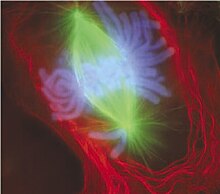
As microtubules find and attach to kinetochores in prometaphase, the centromeres of the chromosomes convene along the metaphase plate or equatorial plane, an imaginary line that is equidistant from the two centrosome poles.[15] This even alignment is due to the counterbalance of the pulling powers generated by the opposing kinetochores, analogous to a tug-of-war between people of equal strength. In certain types of cells, chromosomes do not line up at the metaphase plate and instead move back and forth between the poles randomly, only roughly lining up along the midline. Metaphase comes from the Greek μετα meaning "after."
Because proper chromosome separation requires that every kinetochore be attached to a bundle of microtubules (spindle fibres), it is thought that unattached kinetochores generate a signal to prevent premature progression to anaphase without all chromosomes being aligned. The signal creates the mitotic spindle checkpoint.[16]
Anaphase
When every kinetochore is attached to a cluster of microtubules and the chromosomes have lined up along the metaphase plate, the cell proceeds to anaphase (from the Greek ανα meaning “up,” “against,” “back,” or “re-”).
Two events then occur; First, the proteins that bind sister chromatids together are cleaved, allowing them to separate. These sister chromatids, which have now become distinct sister chromosomes, are pulled apart by shortening kinetochore microtubules and move toward the respective centrosomes to which they are attached. Next, the nonkinetochore microtubules elongate, pulling the centrosomes (and the set of chromosomes to which they are attached) apart to opposite ends of the cell. The force that causes the centrosomes to move towards the ends of the cell is still unknown, although there is a theory that suggests that the rapid assembly and breakdown of microtubules may cause this movement.[17]
These two stages are sometimes called early and late anaphase. Early anaphase is usually defined as the separation of the sister chromatids, while late anaphase is the elongation of the microtubules and the chromosomes being pulled farther apart. At the end of anaphase, the cell has succeeded in separating identical copies of the genetic material into two distinct populations.
Telophase
Telophase (from the Greek τελος meaning "end") is a reversal of prophase and prometaphase events. It "cleans up" the after effects of mitosis. At telophase, the nonkinetochore microtubules continue to lengthen, elongating the cell even more. Corresponding sister chromosomes attach at opposite ends of the cell. A new nuclear envelope, using fragments of the parent cell's nuclear membrane, forms around each set of separated sister chromosomes. Both sets of chromosomes, now surrounded by new nuclei, unfold back into chromatin. Mitosis is complete, but cell division is not yet complete.
Posted by ct Nap at 7:35 PM 0 comments
Mitosis: The Division of Plant & Animal Cells
(These materials and much more can be found on our (Cell Division CD-ROM)
Cell Division Overview
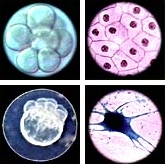
Clockwise, from top left:
embryonic sea urchin cells,
frog skin cells, neuron,
8-cell fish embryo.
All of the living organisms on Earth are made up of one or more cells, which are the simplest units of life capable of independent existence and reproduction. Cells have the extraordinary ability to make nearly identical copies of themselves by the process of cell division. Since new cells are only produced by existing cells, cell division is essential for the continuation of life.
There are a variety of reasons that might cause a cell to divide:
- Multicellular organisms grow in size and complexity by making more cells.
- Old and damaged cells are continuously replaced by the division of cells.
- Single-celled organisms such as bacteria divide to make new, independent organisms.
Two events are required for successful cell reproduction. First, the "parent" cell must ensure that each new "daughter" cell receives a complete copy of its hereditary information. This information is transmitted in the form of complex molecules called DNA, and directs the various activities of the cell throughout its lifetime.
The second requirement is the partitioning of cytoplasm between the two daughter cells.
The Cell Cycle
The orderly program of events in the lifetime of a cell is known as the cell cycle. One cell cycle describes the period between a cell's creation by mitosis, and its subsequent division into two daughter cells. The typical cell cycle is divided into two phases: a brief mitotic phase in which the cell divides its nuclear and cytoplasmic contents, and a longer period between divisions called interphase.
In eukaryotic (plant, animal & fungus) cells, the division of chromosomes and cytoplasm into two cells is known as the mitotic phase. During mitosis and cytokinesis, each of the two daughter cells will receive an exact copy of the parent cell's chromosomes and roughly half of the cytoplasm. A detailed analysis of mitosis is provided on our Cell Division 1 CD-ROM.
It is important to know that the parent cell's chromosomes are replicated during the S (synthesis) phase of the cell cycle before mitosis can begin. The replicates (called sister chromatids) remain attached to each other through early mitosis.
The Phases of Mitosis
Compare and contrast mitosis in the following plant and animal cell pictures:
Prophase
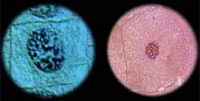
Plant and animal cells: prophase.
The beginning of mitosis is called prophase. In early prophase, the centrosomes move toward opposite poles of the cell, organizing the spindle microtubules between them. The sister chromatids become visible in the nucleus as they condense.
Metaphase
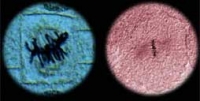
Plant and animal cells: metaphase.
The chromatids remain lined up between the poles of the cell during metaphase.
Anaphase
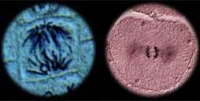
Plant and animal cells: anaphase.
Anaphase begins when the pairs of sister chromatids separate. The separated chromatids are now called chromosomes, and move toward the poles of the cell.
Telophase
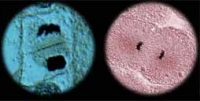
Plant and animal cells: telophase.
The chromosomes arrive at the poles in telophase, and new nuclear membranes form around them.
Cytokinesis
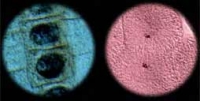
Plant and animal cells: cytokinesis.
Division of the cytoplasmic components is called cytokinesis.
In animal cells, cytokinesis occurs when a ring of actin and myosin filaments constricts the plasma membrane at the equator. Eventually, the parent cell is divided into two cells.
In plant cells, a number of small vesicles fuse at the metaphase plate to form the cell plate. Over time, the cell plate reaches across the cell and joins with the plasma membrane.
Interphase

Plant and animal cells: interphase.
The process of mitosis and cytokinesis creates two separate cells, each with an identical set of chromosomes. After cytokinesis, the daughter cells will enter interphase.
For additional information on mitosis in plant and animal cells, or prokaryotic cell division, see our Cell Division 1 CD-ROM.
Posted by ct Nap at 6:55 PM 0 comments
Mitosis in animal cell
This animation demonstrates the stages of mitosis in an animal cell. Use the control buttons in the upper left to run the complete animation. Click on any intermediate stage (for example, Anaphase), and see a representative still frame.
Events during Mitosis
Interphase: Cells may appear inactive during this stage, but they are quite the opposite. This is the longest period of the complete cell cycle during which DNA replicates, the centrioles divide, and proteins are actively produced. For a complete description of the events during Interphase, read about the Cell Cycle.
Prophase: During this first mitotic stage, the nucleolus fades and chromatin (replicated DNA and associated proteins) condenses into chromosomes. Each replicated chromosome comprises two chromatids, both with the same genetic information. Microtubules of the cytoskeleton, responsible for cell shape, motility and attachment to other cells during interphase, disassemble. And the building blocks of these microtubules are used to grow the mitotic spindle from the region of the centrosomes.
Prometaphase: In this stage the nuclear envelope breaks down so there is no longer a recognizable nucleus. Some mitotic spindle fibers elongate from the centrosomes and attach to kinetochores, protein bundles at the centromere region on the chromosomes where sister chromatids are joined. Other spindle fibers elongate but instead of attaching to chromosomes, overlap each other at the cell center.
Metaphase: Tension applied by the spindle fibers aligns all chromosomes in one plane at the center of the cell.
Anaphase: Spindle fibers shorten, the kinetochores separate, and the chromatids (daughter chromosomes) are pulled apart and begin moving to the cell poles.
Telophase: The daughter chromosomes arrive at the poles and the spindle fibers that have pulled them apart disappear.
Cytokinesis: The spindle fibers not attached to chromosomes begin breaking down until only that portion of overlap is left. It is in this region that a contractile ring cleaves the cell into two daughter cells. Microtubules then reorganize into a new cytoskeleton for the return to interphase.
Need a video of mitosis for classroom use? One is available for immediate download.
Some Keywords:
cell cycle, mitotic spindle, DNA replication, kinetochore, microtubule
Posted by ct Nap at 6:46 PM 0 comments
The meaning of mitosis
Mitosis is the process by which a eukaryotic cell separates the chromosomes in its cell nucleus into two identical sets in two nuclei.[1] It is generally followed immediately by cytokinesis, which divides the nuclei, cytoplasm, organelles and cell membrane into two cells containing roughly equal shares of these cellular components. Mitosis and cytokinesis together define the mitotic (M) phase of the cell cycle - the division of the mother cell into two daughter cells, genetically identical to each other and to their parent cell. This accounts for approximately 10% of the cell cycle.
Mitosis occurs exclusively in eukaryotic cells, but occurs in different ways in different species. For example, animals undergo an "open" mitosis, where the nuclear envelope breaks down before the chromosomes separate, while fungi such as Aspergillus nidulans and Saccharomyces cerevisiae (yeast) undergo a "closed" mitosis, where chromosomes divide within an intact cell nucleus.[2] Prokaryotic cells, which lack a nucleus, divide by a process called binary fission.
The process of mitosis is complex and highly regulated. The sequence of events is divided into phases, corresponding to the completion of one set of activities and the start of the next. These stages are prophase, prometaphase, metaphase, anaphase and telophase. During the process of mitosis the pairs of chromosomes condense and attach to fibers that pull the sister chromatids to opposite sides of the cell. The cell then divides in cytokinesis, to produce two identical daughter cells.[3]
Because cytokinesis usually occurs in conjunction with mitosis, "mitosis" is often used interchangeably with "mitotic phase". However, there are many cells where mitosis and cytokinesis occur separately, forming single cells with multiple nuclei. This occurs most notably among the fungi and slime moulds, but is found in various different groups. Even in animals, cytokinesis and mitosis may occur independently, for instance during certain stages of fruit fly embryonic development.[4] Errors in mitosis can either kill a cell through apoptosis or cause mutations that may lead to cancer.
Posted by ct Nap at 6:43 PM 0 comments








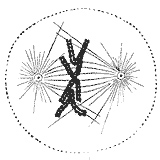



 Watch the Cell Cycle movie.
Watch the Cell Cycle movie. Watch a real animal cell undergo mitosis.
Watch a real animal cell undergo mitosis. Watch an animation of plant cell mitosis.
Watch an animation of plant cell mitosis.